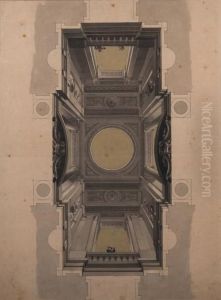Carl Gotthard Langhans Paintings
Carl Gotthard Langhans was a prominent German architect, born on December 15, 1732, in Landeshut, Silesia, which is now known as Kamienna Góra, Poland. He is most renowned for his Neoclassical architectural style, which was innovative for his time and has left a lasting impact on European architecture. Langhans is perhaps best known for designing the Brandenburg Gate in Berlin, one of Germany's most famous landmarks, which was completed in 1791.
Langhans' architectural journey began after he studied at the University of Leipzig, where he was initially drawn to law but soon developed a passion for architecture. His early work was influenced by his travels across Europe, including visits to Italy and France, where he was inspired by the classical architectural principles of antiquity. Upon his return to Prussia, he embarked on a career that would see him contribute significantly to the architectural landscape of Berlin and beyond.
Throughout his career, Langhans designed a variety of structures, ranging from elegant palaces to practical civic buildings. His approach to architecture was characterized by a reverence for classical forms and an emphasis on simplicity and symmetry, principles that were inherent in the Neoclassical movement. Besides the Brandenburg Gate, his notable works include the Theatre in Berlin (now demolished) and the Belvedere on the Pfingstberg in Potsdam, among others.
Langhans' legacy extends beyond his individual projects. He played a crucial role in the transition of architectural styles in Germany from the Baroque and Rococo to Neoclassicism, influencing a generation of architects and contributing to the cultural heritage of Germany and Europe. Carl Gotthard Langhans passed away on January 1, 1808, in Grüneiche, Brandenburg, leaving behind a body of work that continues to be celebrated for its elegance, innovation, and historical significance.

